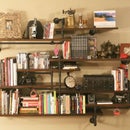Introduction: Welded Steel Planters
This is the first project I welded at TechShop (www.techshop.ws) which truly has a superb welding setup as you'll see in some of the pics.
Required Materials
- 14 gauge mild steel (purchased as salvage w/ lots of aging and character)
Required Tools
- Plasma cutter (or grinder with cutoff wheel)
- MIG welder
- 4-1/2" grinder with sanding disc
- PPE (leather gloves, welding helmet, safety glasses, jeans and long sleeves)
Step 1: Design & Layout
Cut List
- 4 pieces: 4-3/8" x 18" (sides)
- 4 pieces: 5-3/8" x 18" (front & back)
- 2 pieces: 4-3/8" x 5-3/8" (bottom)
Step 2: Cutting & Preparation for Welding
Using a plasma cutter and the framing square as a straight edge I cut out the pieces using the Sharpie guidelines measured out in the previous step. Then to prepare the pieces for welding I used a 4-1/2" grinder with a sanding disc to clean up the sharp edges created during the cutting process.
**IMPORTANT NOTE: Plasma cutters are awesome. If you've never used one before then I highly recommend finding a friend, business, or co-op that will let you experience theirs. You'll never look at metal the same once you realize you can cut through it like a hot knife through butter using this invaluable tool.
Step 3: Welding & Final Cleanup
Using a pair of right angle magnetic clamps and the well calibrated welding tables at TechShop I was able to make quick work of the welds. It seemed to me that the best method was to first weld the four sides of the planters and then weld the bottom caps on last. This process worked fine and produced a good, square result in the end.
The only trick here, if there is any at all, is to apply a few tack welds to the pieces you intend to weld, before welding the entire joint. The tack welds provide a temporary mate that will hold the pieces while checking for square, and will help to resist any deforming or unsettling of the work pieces in case heat is applied to an area for too long.
The final step I took on this project was to clean up all of the weld joints using a 4-1/2" angle grinder with sanding disc. Perhaps "clean up" is the wrong term since the weld joints were already very clean. For an industrial style I find that grinding the weld bead adds a nice aesthetic by putting a shiny, polished look on all the edges in contrast to the weathered, slightly rusted look of the metal faces.
Step 4: Presentation
The end result of this 2 hours of work and roughly $15 in materials is a very robust pair of industrial, minimalist planters. For now I have them paired with lighted branches and a steel table that was designed in the same style, but I can easily envision using them in other settings and for other functions around the house. In fact the weathered metal would look exceptionally nice set off against the vibrant greens of a real plant. I imagine I'll need a hole in the bottom to release excessive moisture in that case, but that's nothing that can't be fixed with 5 minutes and a hand drill when the time comes.
Now I need to go design some things out of wood because certain parts of my house are beginning to look like a factory floor after all the fun I've had with metal since starting welding a few years back. Happy making!













